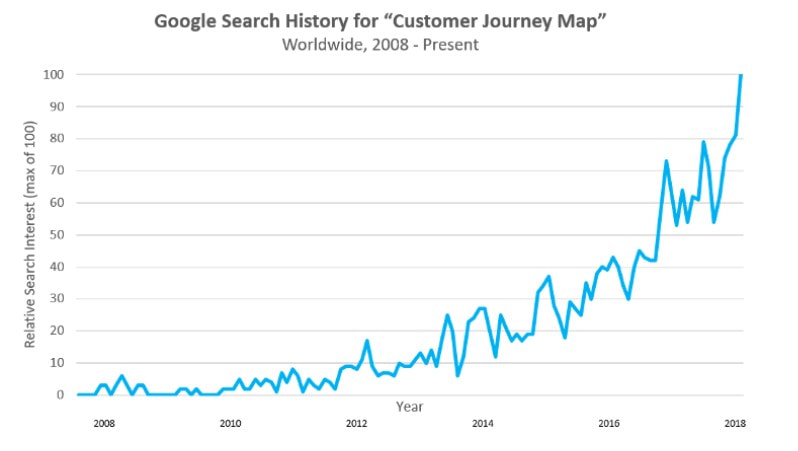|
For quite some time, the world’s top management thinkers have been telling us that customer centricity is the key to success. As the Ubers and the Airbnbs of the world have reaped massive profits by becoming deeply responsive to customer needs, the business community has largely gotten on board. Especially for established businesses, however, being customer centric isn’t that easy. Customers are interacting with your brand in a multitude of different ways. Thinking through a few examples, they may hear about you through an ad, use your product, interact with your chatbots as they work through an issue, and comment about their experience with you on Twitter. There’s a lot of complexity, which is where journey mapping comes in. Regardless of whether you’re looking at customers from a B2B, B2C, or internal (process improvement) lens, journey mapping allows an organization to put itself in the customer’s shoes. From there, you can see the full range of touchpoints they have with your brand from their perspective. This allows us to understand where there is friction today and where there are opportunities to create meaningful value. According to statistics from McKinsey, optimizing the customer journey can boost revenues by 10–15% while simultaneously lowering the cost to serve customers by 15–20%. Another study showed that companies that create formal customer journey maps realize a 54% greater return from their marketing efforts. Journey maps sound great. So what’s the catch? The problem is that the popularity of journey maps has grown exponentially over the past decade, with much of the most important refinement to the art of journey mapping happening within the past few years. Put simply, many organizations aren’t used to creating the kinds of journey maps that translate into actionable next steps. For that reason, we pulled out five best practices to help you get the most out of your maps. Focus on the customer’s perspective. The first key to successfully mapping a customer’s journey is to forget about your own view of the world. Customers behave in conformance with a number of different archetypes, but the one thing that they all have in common is that they see things differently than the businesses from which they’re buying things. They don’t necessarily see all the nuances that a brand sees as differentiating itself, they don’t define the competitive set in the same way, and they don’t care at all about how your back-end operations work to deliver the end product they see. They do, however, have set approaches to how they get things done, and their journey may well be riddled with inefficiencies and frustrations. Talk to customers and observe what they do. In doing so, you’ll better understand not just where there’s room for improvement, but precisely how they define success. Add depth by understanding customers’ “Jobs to be Done.” Much of the literature on journey mapping comes out of the software UX design space. As a result, people who read up on journey mapping tend to be pretty good at identifying the key steps in the user experience. They can identify the key phases of the journey, identify the actions being taken, and record the user’s feelings and satisfaction during each phase. Unfortunately, the doing-thinking-feeling model — while useful for incrementally adjusting discrete features — is insufficient for many broader types of innovation. Just because you understand what a customer is doing and how they feel about it, it doesn’t mean you understand why they’re doing it. The best journey maps identify the functional and emotional “Jobs to be Done” that customers are trying to satisfy. And at a level deeper, they also identify the “job drivers” that make certain jobs more important for different types of people. Once you understand the “why” behind a customer’s actions, you have a much broader toolkit to work with as you explore an expansive set of innovation opportunities. Identify other stakeholders who may be important. When attempting to fix the pain points of software users, it’s often sufficient to understand each user’s journey in isolation. If 20 of your 25 studied users all experience trouble on step 6, then it’s probably time to make an adjustment. But if your goal behind creating journey maps is broader than that — say, designing a new product or revamping the way you sell solutions — you’ll need to understand who all of the different stakeholders are and where their journeys intersect. Optimizing the journey for an end user may not be very important if you don’t understand who would be buying your solution and what’s important to them. And in both B2B and B2C contexts, it’s rare that only one person is involved throughout the course of buying and using something. Widen your lens to achieve broader goals. Beyond finding others who may be involved, it’s important to take a broad view of how the journey is defined. Before the product is used, there may be crucial steps related to planning and shopping. For air travel, as an example, using the “product” may include checking in for the flight, airport security screenings, a boarding process, and the flight itself. But before that, there are critical steps related to researching destinations, coordinating plans with traveling companions, and booking the travel, to name a few. Similarly, the journey may continue past the actual use of a product. Things such as cleanup, disposal of byproducts, reviewing the experience, and purchasing add-ons could all come into play. In our air travel example, customers may want to find interesting attractions at their destination or make dinner reservations. You may not need to explore the entire journey. Perhaps your mandate is focused solely on refining the purchase experience. Whatever the end game, it’s important to align on your goals and uses for your journey maps upfront, so you can ensure that you map all relevant parts of the journey (keeping in mind that phases before or after the ones you’re focused on may impact the phases of interest). Translate your insights into opportunities. Arguably the biggest shortcoming with many journey maps we see is that they stop short of defining the “so what?” They tell you what customers are doing and how they feel about it, so you know where there’s room for improvement but little else. While journey maps are simply a tool to facilitate solution generation down the road, they do need to highlight big opportunities. Beyond just calling out pain points, your maps should identify important jobs that aren’t being satisfied fully. They should highlight the job drivers that cause various customer types to diverge in their behaviors and intent. They should shed light on the most promising areas for innovation. Journey maps can be a valuable tool for cutting costs, increasing revenue, and expanding your innovation potential. But building a useful map requires careful research that asks the right questions and observes unspoken truths. By following our five steps for building better journey maps, you’ll be spotting opportunities in no time. Dave Farber is a strategy and innovation consultant at New Markets Advisors. He helps companies understand customer needs, build innovation capabilities, and develop plans for growth. He is a co-author of the award-winning book Jobs to be Done: A Roadmap for Customer-Centered Innovation. Comments are closed.
|




10/16/2018